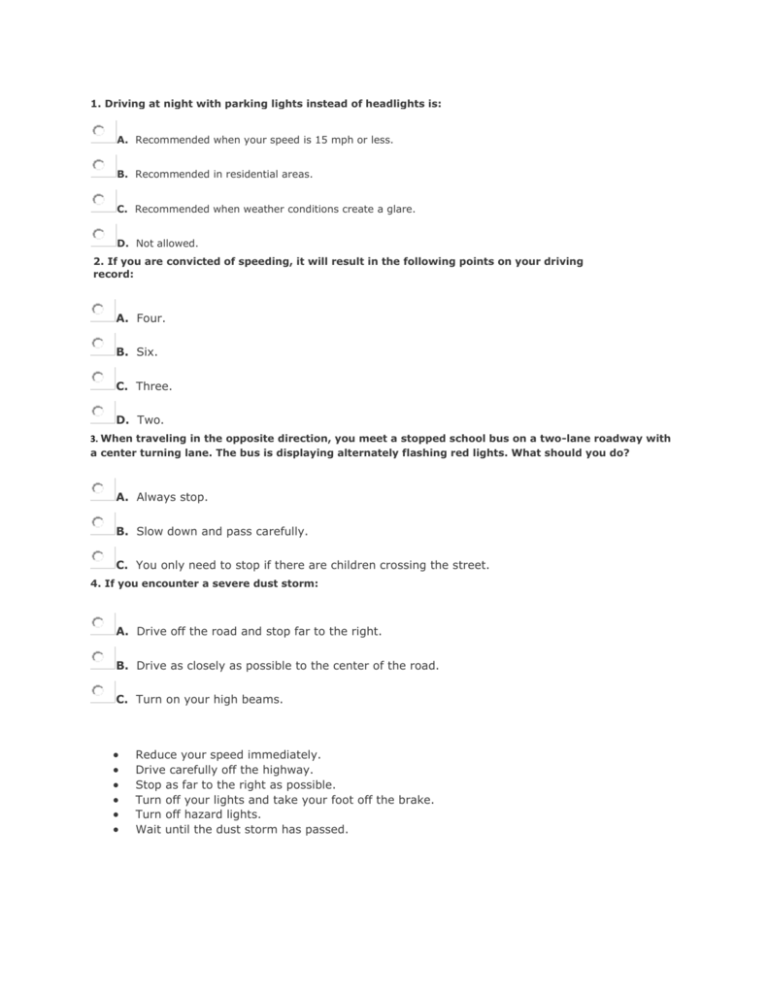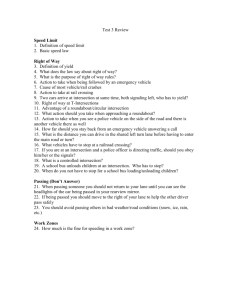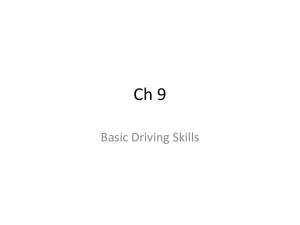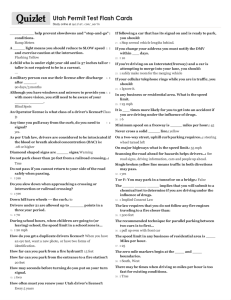New material for permit - International Driving School
advertisement

1. Driving at night with parking lights instead of headlights is: A. Recommended when your speed is 15 mph or less. B. Recommended in residential areas. C. Recommended when weather conditions create a glare. D. Not allowed. 2. If you are convicted of speeding, it will result in the following points on your driving record: A. Four. B. Six. C. Three. D. Two. 3. When traveling in the opposite direction, you meet a stopped school bus on a two-lane roadway with a center turning lane. The bus is displaying alternately flashing red lights. What should you do? A. Always stop. B. Slow down and pass carefully. C. You only need to stop if there are children crossing the street. 4. If you encounter a severe dust storm: A. Drive off the road and stop far to the right. B. Drive as closely as possible to the center of the road. C. Turn on your high beams. Reduce your speed immediately. Drive carefully off the highway. Stop as far to the right as possible. Turn off your lights and take your foot off the brake. Turn off hazard lights. Wait until the dust storm has passed. 5. You must have the following brake system in proper working order: A. A foot brake and a parking brake. B. A foot brake that stops the car within a distance of 50 feet at a speed of 25 miles per hour. C. A parking brake is enough. D. Either a foot brake that stops the car within a distance of 20 feet at a speed of 25 miles per hour or a parking brake. 6. Know signs by their shapes. The eight-sided shape is used for: A. Direction guidance signs. B. Advance warning of No Passing Zones. C. Stop signs. D. Yield signs. 7. What is the light grey area in the picture called? A. Passing zone. B. Safety maneuver angle. C. Mirror visibility. D. Blind spot. 8. Parking your car in front of a driveway is: A. Never allowed. B. Allowed,if the driveway is not frequently used. C. Allowed, if the driveway is private. D. Allowed, if the driveway is public. 9. This is: A. A minimum speed limit sign. B. A maximum speed limit sign. C. An advisory speed sign 10.When following a fire truck responding to a fire alarm, you must keep a distance of: A. At least 100 feet. B. At least 300 feet. C. 500 feet or more. D. No special distance. 11.The driver in front of you signals (left arm extended, with elbow bent upward, at about a 90degree angle): A. That he plans to turn left. B. That there is an emergency. C. That he plans to turn right. D. That he is preparing to slow down or stop. 12. Passing another vehicle on the right on a two-way roadway is: A. Allowed if you use the shoulder. B. Allowed if there is a dashed yellow line on your side of the center. C. Allowed if the vehicle you are passing is making or is about to make a left turn. D. Allowed if the vehicle you are passing is about to stop. 13. Where should you stop at an intersection where there is a stop sign, but no stop line or crosswalk? 14. What is the first thing you should do when your car starts to skid? A. Slam on the brakes. B. Take your foot off the gas pedal (accelerator). C. Turn your steering wheel in the opposite direction of the skid. 15. When driving in a fog, you should: A. Use your low beams B. Allow extra space between your car and the car ahead. C. Reduce your speed. D. All of the above. D. Steer straight ahead. 16.Unless otherwise posted, what is the legal speed limit in a business district? A. 25 mph. B. 40 mph. C. 35 mph. 17. Always signal to other drivers when you: A. Plan to stop. B. Plan to turn left. C. Plan to turn right. D. All of the above 18. Why should you not use your high beam headlights when driving in fog? A. Approaching vehicles might not see you. B. Vehicles behind you might follow too closely. C. The light from your own headlights will reflect back in your eyes. D. You cannot see approaching vehicles in time and might blind them. 19. When you want to exit a freeway, you should: A. Be prepared to stop if there is no room in the exit lane. B. Plan ahead and give yourself plenty of time. C. Always keep your speed until you left the freeway. D. Signal your intention to exit approximately one or two seconds before exiting. 20. If you are convicted of a first violation for knowingly purchasing for or providing spirituous liquor to a minor, your driving privilege will: A. Be revoked. B. Be suspended up to three months. C. Be suspended up to 30 days. D. Not be affected. 21.A curb painted white means: A. Parking is permitted only for a disabled person. B. No stopping, standing, or parking at any time. C. You can stop only long enough to pick up or drop off passengers or mail. D. You can park for a limited time. 22.Before turning left on a two-way road, it is important to: A. Sound your horn. B. Yield to oncoming vehicles. C. Wait until oncoming traffic has a red light. D. Move to the right side of your lane. 23.What is the No-Zone in terms of driving? A. An area where pedestrians cannot cross the street. B. A zone where parking is not allowed. C. The danger areas around a truck. D. A zone where passing is not allowed. 24.If gates are lowered at a railroad crossing for a long time and no train passes, you should: A. Carefully drive around the gate. B. Turn around and take another route. C. Leave the car to make sure no train is approaching, then proceed around the gate. D. Call railroad emergency toll free number, if posted, or 911. 25. Instructions from a flag person in a construction zone: A. Can safely be ignored. B. Is only advisory, but you should proceed with caution and expect the unexpected. C. Must be obeyed, unless there is a sign or signal telling you otherwise. D. Must always be obeyed. 26.If you are convicted of driving in any part of a gore area, it will result in the following points on your driving record: A. Four. B. Six. C. Three. D. Two 27.When are you allowed to pass a school bus? A. If the school bus is in motion. B. If the school bus has stopped, and red lights are flashing. C. If you are signaled by another driver to proceed. D. All of the above. 28.When a traffic signal is showing a steady red light: A. After stopping, you may turn left on any street unless prohibited by signs. B. You may proceed straight ahead after stopping, and when it is safe. C. After stopping, you may turn right on any street unless prohibited by signs. D. You must slow down before entering the intersection, but only if you can do so safely. 29. Know signs by their standard colors. Yellow is used for: A. Direction guidance and to show movements permitted. B. General warning. C. Regulation signs. D. Construction and maintenance warning 30. What should you do at the first sign of rain or snow? A. Drive as closely as possible to the center of the road. B. Turn off your headlights. C. Increase following distance. D. All of the above. 31.The shape of a do not enter sign is: A. Round. B. Five-sided. C. Three-sided. D. Square. 32.Which sign tells you that you must turn left or right on the road ahead? A. B. C. D. 33. Always signal to other drivers when you: A. Plan to turn right. B. Plan to stop. C. Plan to turn left. D. All of the above. 34. What is the best advice to a driver that has taken too many drinks? A. To wait an hour before he or she drives. B. To drink black coffee. C. To take a cold shower. D. To ask somebody who has not been drinking to drive. 35. Which of the following must you obey over the other three? A. A flashing red light. B. A steady red light. C. A police officer. D. A Stop sign. 36. Which of the following is true about driving on a wet roadway? A. Water does not affect cars with good tires. B. As you drive faster, your tires become less effective. C. Deeper water is less dangerous. 37. What is true about a two-way left turn lane? A. You should also use the lane to make a right turn. B. It is safer, but not mandatory, to use the lane for a left turn. C. You should also use the lane to make a U-turn 38.This sign means that: A. You must slow down and proceed with caution. B. You must always bring your car to a complete stop before entering the intersection. Other traffic may not stop. C. All approaching traffic to this intersection must stop. D. You must bring your car to a complete stop, but only if there is a clearly marked line where you should stop. 39. What does defensive driving mean? A. That you should protect yourself and others from dangerous and unexpected driving situations. B. That you should always drive in the right lane on multi-lanes roads. C. That you should drive slower than posted speed limits. D. All of the above. 40. When you enter city traffic from a full stop (pulling away from the curb), you should: A. Not use your turn signals, it might confuse other drivers. B. Make sure you have a large enough gap to get up to the speed of traffic. C. Wait until other vehicles are close enough to see you. D. Always enter your lane slower than traffic flow. 41. You should always allow more space than normal in front of your vehicle when following: A. A passenger car. B. A motorcycle. C. A police car. D. A station wagon. 42.This sign means: A. Merging traffic. B. Crossroad ahead. C. Roadway narrows. D. No passing zone. 43.You must have the following equipment in proper working order for your car to be considered safe: A. Windshield wipers B. Running board courtesy lights. C. A red light showing from the front. D. A bell, siren, or exhaust whistle. 44.What is true about seat belts? A. Using seat belts reduces the risk of being thrown from your vehicle in case of an accident. B. Seat belts are not needed when driving around town. belt. C. In case of an accident, a seat belt usually traps you in the car, since it takes too long to unbuckle a seat D. All of the above. 45.If you have a Arizona driver's license, change of address must be reported within: A. One week. B. 14 days. C. 10 days. D. 30 days. 46.Unless otherwise posted, what is the legal speed when approaching a school crossing? A. 20 mph. B. 15 mph. C. 25 mph. D. 30 mph 47.When approaching an intersection without traffic signals or signs, you must: A. Yield to any vehicle that reaches the intersection before you. B. Yield to all vehicles coming from your left, but not from your right. C. Yield to all vehicles coming from your right, but not from your left. 48. When you park on a hill headed uphill and there is no curb, you should turn your front wheels A. Parallel to and touching the curb. B. Pointing away from the side of the road. C. Pointing to the side of the road. D. Parallel to, and at least 12 inches away 49. If you need to brake in a hurry, what does not affect how far your car will go before you can bring the car to a complete stop? 50.What color do flaggers in construction zones wear on vests, shirts or jackets? A. Orange. B. Black and White. C. Brown. 51. If you get employed and work in Arizona (other than for seasonal agricultural work), you must get an Arizona driver's license: A. Within 30 days. B. Within 7 months. C. Immediately. D. Within 14 days 52.What does this road sign mean ? A. Steep hill. B. Falling rocks. C. Trucks entering the highway 53. Which of the following improves safety and is considered a responsible way of using your cell phone while driving: A. When your cell phone rings, let the call go to voicemail. B. Use your cell phone with hands-free devices. C. Drive to the side of the road and stop before you use your cell phone. D. All of the above. 54. When driving on slippery roads, you should: A. Increase distance to any vehicle ahead. B. Drive as you would on dry roads. C. Drive slightly faster than the speed limit. D. Stay close to any vehicle ahead. 55.The driver in front of you signals (left arm extended downward, with palm of hand to the rear): A. That he is preparing to slow down or stop. B. That he plans to turn left. C. That there is an emergency. D. That he plans to turn right. 56.You can park and leave your car: A. On a bridge. B. On a sidewalk. C. On a crosswalk. D. None of the above. 57.When turning left at an intersection not controlled otherwise by signs or signals, you must: A. Yield the right-of-way to any vehicles coming straight through from the other direction B. Alert any vehicles coming straight through from the other direction and make sure they stop. C. Proceed through the intersection even if there are vehicles coming straight through from the other direction 58.Parallel parking: Choose a space large enough for your car. Signal, and stop even with the front car. The distance between the side of your car and the front car should be about: A. Two feet B. Five feet C. Ten feet D. 16 feet 59.You may always continue carefully against a yellow light if: A. There are no pedestrians crossing. B. You are turning right. C. You are turning left into a one-way street. D. You are already within the intersection 60. When should you use your horn? A. When necessary to avoid accidents. B. To show other drivers that they made a mistake. C. To alert blind pedestrians of your presence D. Before slowing down or stopping in a dangerous situation (emergency stop). 61.When traveling in the opposite direction, you meet a stopped school bus on a two-lane roadway with a center turning lane. The bus is displaying alternately flashing red lights. What should you do? A. Always stop. B. Slow down and pass carefully. C. You only need to stop if there are children crossing the street. 62. You may be charged with Extreme DUI if you: A. Committed DUI while speeding. B. Committed DUI with a BAC of .15 percent or more. C. Committed DUI while subject to a Certified Ignition Interlock Device (CIID) requirement. D. Committed DUI while a person under 15 was in the vehicle. 63.When are you required to stop at a railroad grade crossing? A. When a traffic-control signal indicate that you must stop. B. When a crossing gate is lowered. C. When a visible railroad signal warns of the approach of a train. D. All of the above. 64. When a vehicle is coming toward you at night, lower your high beam headlights when you are within: A. 1,000 feet. B. 500 feet. C. 100 feet. D. 200 feet. 65.Know signs by their shapes. The five-sided shape is used for: A. Stop signs. B. Yield signs. C. Railroad advance warning signs. D. School advance and school crossing signs 66.A truck's blind spots: A. Are bigger than the blind spots of a passenger vehicle. B. Are eliminated with bigger mirrors. C. Can be checked by using rear view mirrors. D. Are eliminated with an additional outside mirror on each side. 67.Unless otherwise posted, what is the legal speed limit on designated open highways? A. 75 mph. B. 70 mph. C. 55 mph. D. 65 mph. 68. If you are being followed closely (tailgated), you should: A. Pump your brakes to alert the driver behind you. B. Move to another lane or turn off the road. C. Speed up, to avoid getting hit from behind. D. Use your horn 69.You have stopped at a railroad crossing with more than one track. After a train has passed, you should: A. Pass the first track, stop before crossing the second and watch for another train. B. Wait until you have a clear view of both tracks. C. Move forward as soon as the train passes 70. To avoid last minute moves, you should: A. Keep your eyes moving. B. Look down the road 10 to 15 seconds ahead of your vehicle. C. Keep a good space between your car and the car ahead. D. All of the above. 71. Chances of hydroplaning increase: A. With decreased following distance. B. With increased speed. C. With reduced visibility 72.When you see this sign, you should: A. Drive to the side of the road and stop. B. Slow down and be prepared to yield to other traffic. C. Drive slowly and carefully since there are several curves ahead. D. Continue straight ahead without reducing speed 73. If you approach a school bus from either direction and the bus is displaying yellow flashing lights, it tells you: A. That the bus is about to stop. B. That you must stop. C. That you should try to pass as soon as possible. 74. If you see orange construction signs and cones on a freeway, you must: A. Change lane, because your lane ends ahead. B. Watch for workers and equipment ahead. C. Change lanes and maintain your current speed. D. Decrease distance to any car ahead. 75.A driver is turning at an intersection without a traffic light, and a pedestrian is crossing. Who must yield? A. The pedestrian. B. The driver. C. Whoever is slower. D. Whoever entered the intersection last. 76.Parallel parking - When backing into a space large enough for your car and toward the curb, you should quickly turn your steering wheel all the way to the left: A. When your back bumper is 18 feet from the car behind you. B. When your front bumper is three feet behind the rear bumper of the car ahead. C. When your front bumper passes the rear bumper of the forward car. 77.When turning in the direction of a green arrow, you must: A. Insist on the right-of-way. B. Yield to vehicles and pedestrians already in the intersection. C. Proceed as quickly as possible in the direction of the arrow. D. Only turn left 78. What is true about large trucks? A. They take longer to stop than a car traveling at the same speed. B. When turning, the rear wheels follow a shorter path than the front wheels. C. They have bigger blind spots than most passenger vehicles. D. All of the above. 79. When should you not use your horn? A. To show other drivers that they made a mistake. B. To alert blind pedestrians of your presence C. When another driver is going too slow. D. All of the above. 80. With a valid Arizona operator license (class D) you may: A. Tow a farm trailer weighing 26,000 lbs. B. Tow a trailer vehicle weighing 20,000 lbs. C. Drive a single unit vehicle weighing 26,000 lbs. 81. What is true about giving a signal before stopping? A. It is not necessary to signal before stopping. B. You may use hand-and-arm signals. C. You must use the vehicles signal lights only. 82. Which of the following statements about making a good right turn is false? A. Try to make the turn as wide as possible. B. Drive close to the right edge of the road. C. Begin signaling at least 100 feet before the turn. 83. An opened container of wine: A. May only be carried in the trunk or in a place where driver or passengers Do not sit. B. May only be carried in the glove compartment. C. Can always be carried inside a passenger vehicle. D. Can only be carried inside a passenger vehicle if you are 21 years of age or older 84.Know signs by their shapes. The square shape is used for: A. Warning signs. B. Railroad crossings. C. Regulation signs. D. Stop signs. 85. If you convicted a second time for racing on the highways, you driving privilege will be: A. Suspended for 12 months. B. Revoked. C. Suspended for two years. D. Suspended for six months. 86. If your car is equipped with an air bag on the passenger side, you should: A. Let small children ride in the back seat. B. Always use rear-facing child passenger restraint system in the front seat. C. Always let small children ride on the passenger side. 87. What type of pavement marking separates traffic traveling in opposite directions? A. White solid lines. B. White broken lines. C. Yellow lines. 88. When should you use your parking lights? A. If weather conditions require you to use your windshield wipers. B. At night and when approaching another vehicle from behind. C. When driving in a fog. D. None of the above. 89. Owners of motor vehicles must have at least the minimum amount of liability insurance. The amount for injury of two persons is: A. 40,000 dollars B. 30,000 dollars C. 15,000 dollars D. 45,000 dollar 90. When stopped by a law enforcement officer, you should not: A. Roll down your window. B. Exit your vehicle. C. Activate the vehicle's hazard lights or emergency flashers. D. All of the above 91. You are approaching a stopped emergency vehicle on a multi-lane roadway. The vehicle has its emergency lights activated. What should you do? A. Turn on your headlights. B. Keep your speed, and avoid stopping. C. Vacate the lane closest to the emergency vehicle, if possible 92. When should you use your high (upper) beam headlights? A. When driving in a fog. B. At night and when approaching another vehicle from behind. C. At night and in open country with a clear road ahead. D. None of the above






